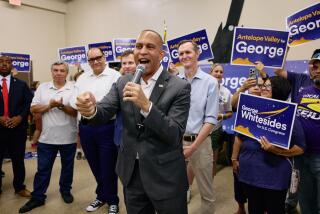Democratic candidates try something new to cope with anti-Pelosi campaign attacks: Disavowing her

Reporting from Washington — The morning after Democrat Conor Lamb’s electoral upset in a Pennsylvania House district that backed Donald Trump by 20 points, House Minority Leader Nancy Pelosi shrugged off questions about whether she was worried that the candidate had campaigned on a pledge to replace her.
“We won,” said the ever-confident Pelosi. “I just wanted him to win.”
For the record:
11:10 a.m. March 22, 2018A previous version of this story said Doug Applegate was part of the Democratic Congressional Campaign Committee’s Red to Blue program. He participated in 2016, but not in 2018.
Pelosi has been the reluctant star of GOP attack ads for years, typically cast as a stereotypical San Francisco liberal who wants to raise taxes and collect all the guns.
And in an election year where there is a chance she could once again lead the Democratic caucus to the majority and become House speaker, expect Republicans to flood the airwaves with ads connecting candidates to the long-serving leader.
But as Lamb’s victory showed, the Democratic Party appears to have an unconventional new strategy for dealing with anti-Pelosi campaign ads in 2018: Disavow her.
Rather than defend Pelosi or try to change the subject, Democratic candidates are being given leeway — at least unofficially — to buck her if that’s what’s needed to win a seat in a conservative-leaning district — or even in a moderate one, since voters seem to be asking for broad change.
It’s a bold strategy that may short-circuit GOP efforts to use her as their boogeyman. But it could also leave Pelosi — who increasingly has had to fight back efforts to push her aside as leader — without the votes she’ll need to get the gavel again.
In the final weeks of the Pennsylvania race, Lamb announced he wouldn’t support Pelosi. “I think we need new leadership on both sides,” Lamb told the Pittsburgh Post-Gazette.
Lamb has faced no backlash from his party’s campaign arm for what some might view as disloyalty toward the Democrats’ top fundraiser, and Democrats on Capitol Hill, including Pelosi, are giddy about his win.
Bolstered by Trump’s unprecedented disapproval ratings, Democrats are reaching into traditionally Republican districts as they seek the 24 seats needed to reclaim the House majority. Candidates running for conservative and moderate seats are studying the Lamb race to see if they should take a similar stand, Brookings Institution senior fellow John Hudak said.
“There will be plenty of situations where a candidate may not have a choice and if the party is serious about winning they have to [recognize that],” Hudak said. “If given the choice between a Republican majority and someone else becoming speaker, I think you’d see her pick a Democratic majority every time.”
There’s already been grumbling among rank and file Democrats over whether Pelosi has led the caucus too long, even among fellow Californians in leadership. The caucus overwhelmingly elected to keep her as their leader in the House in 2016, but the 134-63 result was closer than any previous attempts to replace Pelosi.
“She has to be thinking about the reality that if the majority is too narrow then her speakership may not be achievable,” Hudak said. Still, “if I had to bet on it, I would bet on Nancy Pelosi’s political savvy finding a way back into the speakership. The odds are she knows exactly how many individuals would really be forced to say publicly that they wouldn’t elect her speaker and [she’ll] make sure that number remains low.”
Lamb isn’t the only Democratic candidate who has said he won’t back Pelosi for speaker. Paul Davis, one of the candidates in the Democratic Congressional Campaign Committee’s Red to Blue program, has long said he won’t support Pelosi.
Several California candidates have been leery of committing to Pelosi. Democrat Doug Applegate, who is running to replace Rep. Darrell Issa of Vista, has been the most direct, saying at a candidate forum in February, “We can do better. We need to move in a different direction.”
Party spending has not geared up yet, and no candidate in Applegate’s race has gotten support from the party during the primary. But Democrats’ campaign arm spent $312,500 against Lamb’s opponent despite his refusal to back Pelosi.
National Republican Congressional Committee spokesman Matt Gorman said Republicans plan to point out candidates who publicly say they won’t support Pelosi but also accept help from the DCCC. Pelosi raises millions for the DCCC each year, and the super PAC connected with her, House Majority PAC, is expected to be a major player in 2018.
“If they want to separate themselves from Pelosi they have to separate themselves from the gravy train as well,” Gorman said.
Typically candidates seek help from party leaders, knowing it can mean a cash boost for their campaigns and better committee options when they get to Washington, said Matthew Green, a political scientist at Catholic University and author of “The Speaker of the House: A Study of Leadership.”
“Historically speaking no, it’s not something that candidates did,” Green said of Democratic candidates distancing themselves from Pelosi. “What we’ll find out in November is are these people actually going to vote against Pelosi and will there be retribution for doing so?”
Already some candidates defer when asked about whom they’ll support as speaker, and Green said that “wiggle room” might be what Pelosi is counting on to get the votes she needs.
On the Republican side, few candidates would dare to openly disavow Trump and risk the wrath of his tweets or hard-core supporters, and so far they haven’t distanced themselves from House Speaker Paul D. Ryan (R-Wis.) either. Those who criticized GOP “establishment” leaders, like former House Speaker John A. Boehner of Ohio, usually found themselves cut off from the party’s support.
Tarring candidates as pawns of Pelosi has been a GOP tactic since she was elected in 2007 as the first female speaker. Ads have portrayed her as a monster destroying a city or a puppet master pulling the strings.
It seemed to have worked as recently as June 2017, when Democrat Jon Ossoff in Georgia’s 6th Congressional District lost to his GOP rival after a campaign that portrayed him as a pawn of Pelosi. She raised funds for his race; he refused to say whether he would support her as leader.
“They can’t win on the issues, so they go after a person,” Pelosi told reporters recently of the GOP ads in Lamb’s race.
In the last three elections, no congressional leader came close to being mentioned in political ads as often as Pelosi, according to the Wesleyan Media Project, which tracks all broadcast political advertisements.
“The attempts to use Nancy Pelosi [are] failing at this point, and I think quite frankly it’s sexist. They need to move on,” said House Democratic Caucus Chairman Joseph Crowley, a New York Democrat among the members expected to seek the speakership if Pelosi doesn’t.
Republicans say they aren’t going to stop using her, especially with the threat of Pelosi becoming speaker again in the 2018 campaign.
“I know Democrats like to laugh at the strategy, but it works and it has worked and it will continue to work,” Gorman said.
Gorman said in poll after poll Pelosi is the most unpopular leader on Capitol Hill, and when Republicans can argue that the Democratic candidate will vote as she wants, it has an effect.
“It’s less about who they will vote for in the one vote of the leadership election and more about who they will vote for every single day,” Gorman said.
Follow @sarahdwire on Twitter
Read more about the 55 members of California’s delegation at latimes.com/politics
ALSO:
For political street fighter Nancy Pelosi, there’s new power in opposing Trump
California could flip the House in 2018, and these 14 races will make the difference
Updates on California politics
More to Read
Get the L.A. Times Politics newsletter
Deeply reported insights into legislation, politics and policy from Sacramento, Washington and beyond. In your inbox three times per week.
You may occasionally receive promotional content from the Los Angeles Times.











